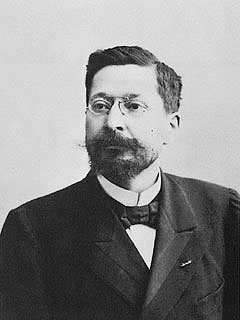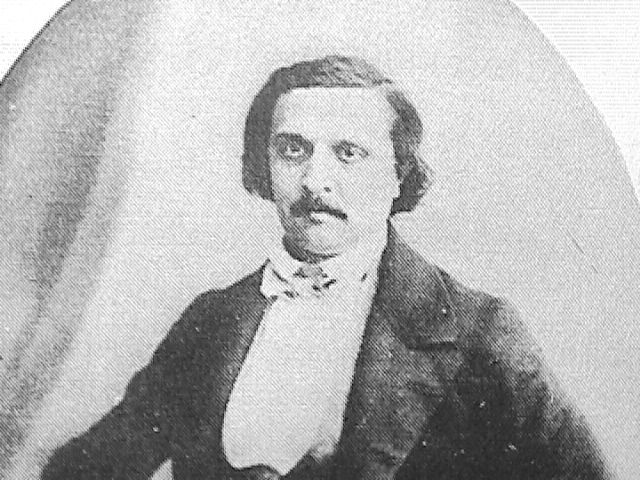Auguste Laurent
Auguste Laurent ( born November 14, 1807, at the district of La Folie the municipality of Saint -Maurice near Langres, † April 15, 1853 in Paris), actually Augustin Laurent, was a French chemist. Laurent was an organic chemist, he presented for the substitution in organic chemistry, the core theory. He has defined the terms molecule, atom, chemical equivalent for organic chemistry. He realized that the number of hydrogen atoms in organic compounds without nitrogen was always straight, with a nitrogen atom in the molecule, the number of hydrogen atoms was always odd.
Life
He was born as the second of the four children of farmer Jean -Baptiste Laurent and Marie -Jeanne Maistre. In Gray ( Haute -Saône ), he received a traditional and classical education at one of the local Collège. Of 9 December 1826 until 1829 was training at the École des Mines, in June 1830, he is Ingénieur Civil des Mines, 1831 répétiteur at the École Centrale des Arts et Métiers. His first scientific paper was published in 1830, which he had co-written with Guy -Adolphe Arrault ( 1806-1861 ), Fabrication du Smalt ou bleu de cobalt, à Querbach, en Basse- SILESIE. In this work, their experiences with the cobalt mining are represented, which he collected during a journey which took him through Lower Silesia.
He was a student of the chemist Jean -Baptiste Dumas. After a dispute with Dumas he was employed in 1833 in the factory Manufacture de Sèvres, 1836 in a porcelain factory in Eich ( Luxembourg ). In 1838 he was appointed professor at the University of Bordeaux. In 1839 he married Anne -Françoise Schrobilgen from a known family Luxembourg. Her son was Matthieu Paul Hermann Laurent ( 1841-1908 ). In 1844 he was appointed a Knight of the Legion of Honour.
Following student unrest, he left Bordeaux ( 1845) and received a position at the Mint of Paris (1848 ). Together with the chemist Charles Gerhardt (1816-1856) he founded in 1851 in Paris, a teaching laboratory for chemistry.
Auguste Laurent died in 1853 at the age of 45 from tuberculosis.
His son was the later mathematician Hermann Laurent.
Scientific work
Syntheses and analyzes
Laurent Dumas examined together with the naphthalene. The molecular formula ( C20H16 C10H8 or ) could be determined from the elemental analysis. Later, determinations of chrysene and pyrene.
Naphthalene allowed to react with chlorine to chlorine - naphthalene. Since structural formulas in chemistry were still unknown, Laurent could only demonstrate that the hydrogen atom has been replaced by a chlorine atom. Naphthalintetrachlorid could also be produced by treatment with chlorine. He could phthalic acid and phthalimide and phthalic anhydride manufacture (1836 ) Oxidation of this material with nitric acid.
From the anthracene Laurent won by oxidation with nitric acid anthraquinone (1835 ). In 1841 he received from the oxidation of the dye indigo isatin. Ethanol and diethyl ether illustrates Laurent as organic derivatives of water. If a hydrogen atom of the water is replaced by an ethyl group obtained ethanol, two hydrogen atoms are replaced by ethyl groups obtained diethyl ether.
Atoms, molecules, equivalents
Laurent realized that the number of hydrogen atoms in an organic molecule - was always straight - as long as no nitrogen was present.
As Laurent began his investigations, there was no clear distinction between atom, molecule, equivalent. Charles Gerhardt had recognized the inaccuracy with respect to the atomic masses in the light of Avogadro's theory of organic molecules. However, the notion of the equivalent of Gerhardt remained very unclear and controversial. Laurent improved the findings of Gerhardt and was the first time a detailed definition of molecules, atoms, equivalents.
Laurent understood by the molecular weight of an element or a compound, the amount by weight which occupied the same gas chamber under the same conditions. For gases of hydrogen, chlorine, oxygen, nitrogen, two parts by weight (double atoms) had to be carried in the gas space. For organic molecules in the gas space, the correct molecular weights were so.
The molecule was the smallest amount necessary to form a chemical compound for Laurent. The atom was the smallest amount of an element which is present in the composite materials for him.
It was not until around 1850 when Alexander William Williamson took a Etherdarstellung of ethanol and ethyl bromide, could be demonstrated that ether is a descendant of ethanol and ethanol a descendant of water.
The ideas of Laurent and Gerhardt now found in books and magazines input.
Core theory
Since usually the carbon backbone did not change in the reactions of hydrocarbons such as naphthalene, anthracene, and only the hydrogen atoms have been replaced by chlorine or oxygen, Laurent formulated the core theory to explain the spatial structure of organic compounds. Already Dumas was able to prove the candle wax that hydrogen atoms can be replaced by chlorine atoms. He had shaped together with Justus von Liebig the term radical substitution.
Laurent used the term radical for atomic nuclei. Later he used the term radical even for larger groups of atoms. For organic molecules, there are different than in inorganic chemistry stem nuclei of carbon atoms. The carbon stem nuclei are arranged in space and can have side - nuclei of hydrogen, chlorine or oxygen atoms take on geometrical and stoichiometric laws. Only some certain side - nuclei in the molecule can secede and form a radical.
Laurent suspected that stem nuclei could be in the center of a pyramid, located at the edges of the pyramid secondary nuclei such as hydrogen, oxygen and halogen atoms leave the exchange under certain reaction conditions. This is the core theory (chemistry).
Works (selection)
- Laurent Auguste; Arrault, Guy -Adolphe: Fabrication du Smalt ou bleu de cobalt, à Querbach, en Basse- SILESIE. Annales de l'Industrie Francaise et Étrangère et Bulletin de l' École Centrale des Arts et Manufacture, ( 1830), p.474










